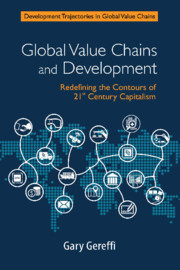Book contents
- Frontmatter
- Dedication
- Contents
- List of Tables
- List of Figures and Boxes
- Foreword
- Acknowledgments
- Sources
- 1 The Emergence of Global Value Chains: Ideas, Institutions, and Research Communities
- Part I Foundations of the Global Value Chain Framework
- Part II Expanding the Governance and Upgrading Dimensions in Global Value Chains
- Part III Policy Issues and Challenges
- 11 Global Value Chain Analysis: A Primer (Second Edition)
- 12 Global Value Chains, Development, and Emerging Economies
- 13 Risks and Opportunities of Participation in Global Value Chains
- 14 Global Value Chains in a Post-Washington Consensus World
- 15 Protectionism and Global Value Chains
- Co-authors
- Index
12 - Global Value Chains, Development, and Emerging Economies
from Part III - Policy Issues and Challenges
Published online by Cambridge University Press: 09 November 2018
- Frontmatter
- Dedication
- Contents
- List of Tables
- List of Figures and Boxes
- Foreword
- Acknowledgments
- Sources
- 1 The Emergence of Global Value Chains: Ideas, Institutions, and Research Communities
- Part I Foundations of the Global Value Chain Framework
- Part II Expanding the Governance and Upgrading Dimensions in Global Value Chains
- Part III Policy Issues and Challenges
- 11 Global Value Chain Analysis: A Primer (Second Edition)
- 12 Global Value Chains, Development, and Emerging Economies
- 13 Risks and Opportunities of Participation in Global Value Chains
- 14 Global Value Chains in a Post-Washington Consensus World
- 15 Protectionism and Global Value Chains
- Co-authors
- Index
Summary
Global Value Chains and International Competition
Globalization has given rise to a new era of international competition that is best understood by looking at the global organization of industries and the ways in which countries rise and fall within these industries (Gereffi, 2011). Using core concepts like ‘governance’ and ‘upgrading’, global value chains (GVCs) highlight the ways in which new patterns of international trade, production, and employment shape prospects for development and competitiveness. GVC analysis documents the international expansion and geographic fragmentation of contemporary production networks and focuses primarily on the issues of industry (re)organization, coordination, governance, and power in the chain (Gereffi and Lee, 2012). Its concern is to understand the causes and consequences of the organizational reconfiguration taking place in global industries. The GVC approach also explores the broader institutional context of these linkages, including trade policy, regulation, and standards.
In the past two decades, profound changes in the structure of the global economy have reshaped global production and trade and have altered the organization of industries and national economies (Gereffi, 2014). As supply chains became global in scope, more intermediate goods were traded across borders, and more imported parts and components were integrated into exports (Krugman, 1995; Feenstra, 1998). In 2009, world exports of intermediate goods exceeded the combined export values of final and capital goods for the first time, representing 51% of non-fuel merchandise exports (WTO and IDE- JETRO, 2011: 81). Because of the unique ability of the GVC framework to show how international supply chains link economic activities at global, regional, national, and local levels within particular industries, international organizations such as the United Nations Conference on Trade and Development (UNCTAD), the Organisation for Economic Co-operation and Development (OECD), the World Bank, and the World Economic Forum are utilizing the GVC approach to structure new donor initiatives and data collection programs on global trade and development (UNCTAD, 2013; OECD, 2013; Cattaneo et al., 2010; World Economic Forum, 2013).
Emerging economies are playing significant and diverse roles in GVCs (Gereffi and Sturgeon, 2013). During the 2000s, they became major exporters of intermediate and final manufactured goods (China, South Korea, and Mexico) and primary products (Brazil, Russia, and South Africa).
- Type
- Chapter
- Information
- Global Value Chains and DevelopmentRedefining the Contours of 21st Century Capitalism, pp. 343 - 380Publisher: Cambridge University PressPrint publication year: 2018

